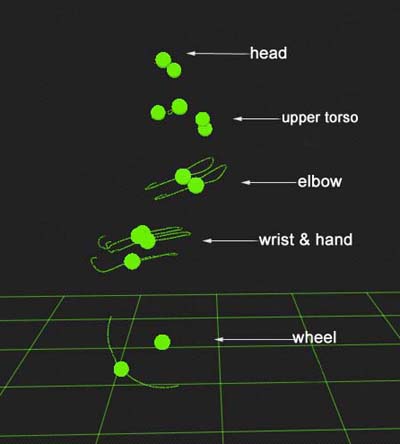Spinal Cord Injury Update
Spring 2005: Volume 14, Number 2
Arm and Shoulder Pain in SCI: Seeking Solutions
Many people with SCI who use manual wheelchairs develop chronic, disabling arm, shoulder or hand pain that interferes with daily life. Studies have found that between 31%-73% of persons in the SCI population have shoulder pain, and 49%-73% have painful carpal tunnel syndrome.
Despite the frequency of these syndromes, little is known about their specific causes or how to prevent them, and treatments are not always effective.
In order to unravel this mystery, the Northwest Regional SCI System at the UW Department of Rehabilitation Medicine is collaborating with two other SCI centers (University of Pittsburgh and the Kessler Institute) on a study of wheelchair propulsion and transfer techniques in the SCI population. "These two wheelchair techniques involve significant repetitive loading on upper limbs and most likely are the primary reasons for injury," says Michael Chang, MD, PhD, UW associate professor of rehabilitation medicine and principal investigator for the Seattle arm of the study.
With funding from the National Institute on Disability and Rehabilitation Research (grant H133A011107), the 5-year study, called "Collaborative Upper Limb Pain," began in 2002 and will eventually enroll 225 participants from the three centers.
Chang and his UW colleagues are recruiting persons with SCI below T1 who use a manual wheelchair and have been injured more than 12 months. Participation involves coming to the UW for an interview; a nerve conduction study, brief physical exam, and imaging studies (MRI and ultrasound) to assess abnormalities in the shoulder and arm; and biomechanical studies that record how participants use their arms during wheelchair propulsion and transfer. These study activities are scheduled for the convenience of participants and can all be done in one visit. Subjects are paid $100 for participating; parking is free. The subject is asked to complete a brief follow-up telephone questionnaire about upper limb pain twice-yearly for the remainder of the study period.
A unique aspect of the study is the biomechanical testing conducted by research scientist Bob Price in the UW's state-of-the-art Human Motion Analysis Lab, using sophisticated technology that was refined and in some cases developed specifically for this project. Price starts by switching one of the participant's wheels for a "SmartWheel" that measures the amount of force the subject applies on the push rim. Next, Price and research assistant Zachary Ashwell help the subject roll onto a platform and secure the wheelchair so the rear wheels are in contact with two metal cylinders that allow the wheels to turn without moving forward. "It's basically a treadmill for wheelchairs," Price explained.

Figure 1: Bob Price, rehabilitation medicine research scientist for the study of upper limb pain in persons with SCI, places reflective markers on study participant Tammy Wilber, whose wheelchair has been secured onto a treadmill-like platform. While Wilber pushes her wheels, infrared cameras capture and digitize information from the markers, employing the same technology used to create the creature Gollum's movements in the movie Lord of the Rings. Participants receive $100 for completing the study. .
Reflective markers are placed at strategic locations on the subject's head, shoulder, neck, wrist, elbow, and on the hub and rim of the wheel. While the subject pushes the wheels, information from the markers is captured by five infrared cameras placed around the room and transmitted to a computer. Software developed by Price quantifies the parameters of the markers and joint angles, reconstructs the positions in 3-D space, and superimposes pushrim force data from the SmartWheel.
"This is the same technology used to create Gollum's movements in the Lord of the Rings movie and the Tom Hanks character in Polar Express," Price said. On the computer screen, the markers show up dramatically as little points of light—like stars in a constellation—in motion against a black background.

Figure 2: Computer image of study participant during biomechanical testing of wheelchair propulsion. Green dots are the reflective markers placed on the subject's torso, upper limbs, and wheel. Information from the markers is captured by infrared cameras and transmitted to the computer. Special software quantifies the parameters of the subject's wheelchair propulsion technique and reconstructs it in 3-D space on the computer screen .
Subjects perform this activity for 30-60 seconds at three different speeds. They also are asked to carry out acceleration, braking and transferring activities while data are recorded. These data, along with information about upper limb pain and disability from questionnaires, MRIs, etc., are sent to the study's coordinating center in Pittsburg for analysis.
"We're trying to correlate evidence of injury to the way people are using their wheelchairs," Price said. "Eventually we want to see what variables are related to injury and abnormalities. If we understand the injury mechanism, hopefully we can improve propulsion techniques and wheelchair designs to prevent these kinds of injuries." The researchers need a large number of subjects in order to get a reliable and complete picture of what's causing these problems.
While participants don't get any direct personal benefit from taking part in the study (aside from $100), contributing toward a worthy research effort has other rewards. "Research is really important," said Tammy Wilber, who participated in the study and recommends others give it a try. "If you can give a few hours to benefit the lives of people with SCI, it's worth it. Plus, it's fascinating! When I watched (the documentary about) how they made Gollum in the movie, I could say, 'Hey, I did that!'"





